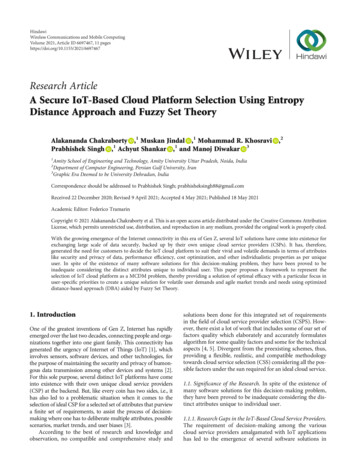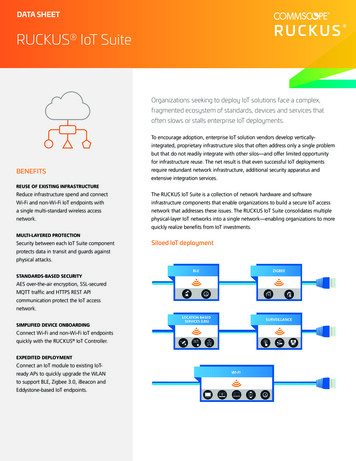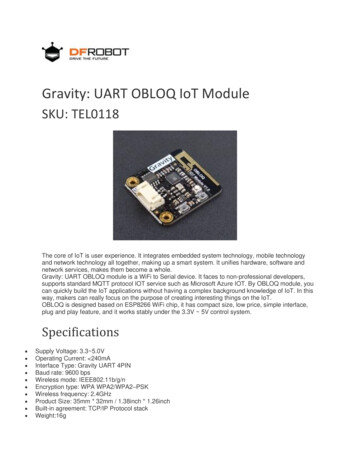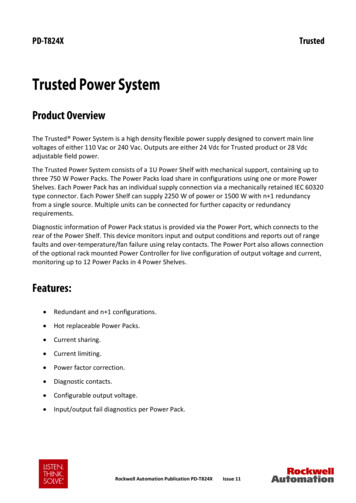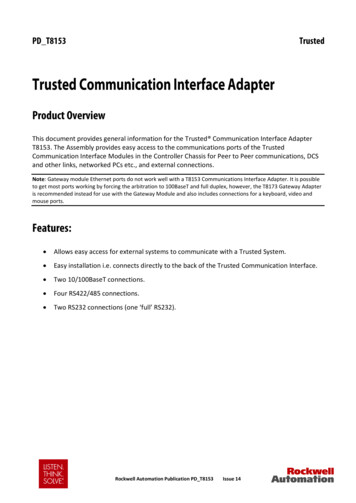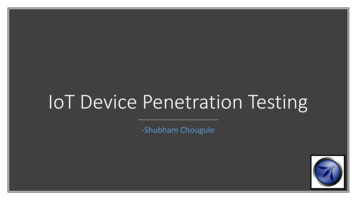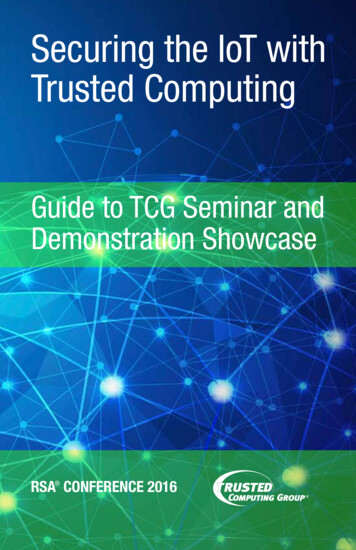
Transcription
Securing the IoT withTrusted ComputingGuide to TCG Seminar andDemonstration ShowcaseRSA CONFERENCE 2016
Seminar Schedule
8:30WELCOME / introduction to sessionmark schiller8:40 – 9:15keynote:Trust-Based Security for Multidimensional Cloudsdoug cahill9:15 – 10:00Senior Analyst for Cybersecurity,Enterprise Strategy Group (ESG)panel 1:IoT, Trust, and SecurityModerator:Panelists:10:00 – 10:10TCG Executive DirectorDarin AndersenCEO and President, CyberTECHmax SengesProduct Manager, Google ResearchLee wilsonProduct Development Engineer,Security InnovationUPDATE FROM TCG and DEMO highlightsmark schiller10:10 – 10:55panel 2:Things to Do with the TPMModerator:Panelists:paul RobertsEditor and Chief, Security LedgerMatthew garrettPrinciple SecuritySoftware Engineer, CoreOSpaul EnglandSoftware Architect, Microsoft10:55 – 11:05BREAK11:05 – 11:50panel 3:Network Security in the IoTModerator:Derek HarpPanelists:tony sagersteve venema11:50 – 12:00TCG Executive DirectorDirector for ICS Global Programs,SANS InstituteSenior VP and Chief EvangelistCenter for Internet SecuritySenior Security Analyst, PolyverseEnd of Seminar—Live Raffle Drawing for PrizesRAFFLE DRAWING PRODUCTS DONATED BY Drive Trust Alliance Infineon12:00 – 12:30 Intel MicronDEMONsTRATION SHOWCASEmoscone west room 2006/2008Trusted Computing Group 1
BRIEF WELCOME / introduction to sessionmark schillerExecutive DirectorTrusted Computing GroupKeynoteTrust-Based Security for Multidimensional Cloudsdoug cahillSenior Analyst for CybersecurityEnterprise Strategy Group (ESG)panel 1:IoT, Trust, and SecurityDarin Andersen, ModeratorCEO and PresidentCyberTECHmax Senges, PanelistProduct ManagerGoogle Researchlee Wilson, PanelistProduct Development EngineerSecurity Innovation2RSA Conference 2016
panel 2:Things to Do with the TPMPaul Roberts, ModeratorEditor In Chief & FounderThe Security LedgerMatthew Garrett, PanelistPrincipal Security Software EngineerCoreOSpaul england, PanelistSoftware ArchitectMicrosoftpanel 3:Network Security in the IoTDerek Harp, ModeratorDirector for ICS Global ProgramsSANS Institutetony sager, PanelistSenior VP and Chief EvangelistCenter for Internet Securitysteve venema, PanelistSenior Security AnalystPolyverseTrusted Computing Group 3
Demonstration Showcase4RSA Conference 2016
Member Company DirectoryTO SEMINAR1. Tempered Networks2. Fujitsu3. JW Secure4. Microsoft5. Microsoft6. CoSoSys7. Aruba8. Micron9. Dell10. PulseSecure11. PulseSecure12. WinMagic13. Industrial Internet Consortium14. Drive Trust AllianceTrusted Computing Group 15. Fraunhofer16. Infineon GlobalSign17. Infineon WIBU Systems18. Cisco HSR Infineon19. Intel20. Intel Book Signing21. Intel22. Intel23. Intel Landesk24. Huawei Infineon25. Anvaya Solutions26. Embedded Computing Design27. Security Ledger28. TCG “Ask #TPM Expert”5
Think Outside the Box — Secure your TLS!The TLS (Transport Layer Security) protocol is the underpinning of secure transfer of information on the Internettoday. TLS v1.2 is the current standard with TLS v1.3 on the horizon.The TLS protocol uses cryptographic operations which have been traditionally implemented in software. Thenon-crypto operations in TLS include the functionality satisfying the SSL/TLS protocol requirements, and alsothe functionality interfacing to the TCP/IP network layers.The TLS protocols are innately robust from the security point of view. However, their implementations usingsoftware library modules are beset with vulnerabilities which have been exploited for the last several years.In our demo we present the hardening of the native security offered in the definition of TLS v1.2 and v1.3protocols by embedding the crypto operations and TLS function calls inside dedicated fixed function hardware.VISIT OURDEMO6#25RSA Conference 2016
SECURING IoT WITH TRUSTED COMPUTINGTrusted Computing Technologies Supported: TPM and TNCThe Use Case for this demonstration is a deployment of IoT sensors and actuators (perhaps those found ina Smart Building) managed by a Cloud-based application that is remote to the sensors (such as the BuildingManagement application). The server and the IoT devices are connected over the public Internet, using anOpenSSL connection. Mutual authentication of devices is required at session start.TCG technology (TPMs to protect credentials and TNC to validate credentials) is applied to the use case byextending OpenSSL authentication. Instead of single factor, using certificates only, the enhanced Open SSLauthentication process requires a certificate and an integrity report (both protected by a TPM on each device).Servers and gateways perform local validation of the integrity reports. If both credentials are validated, anOpenSSL session for data exchange is started. IoT devices validate the SSL certificate from the gateway inconventional, single factor OpenSSL authentication.The demo includes an extensive GUI showing activity logs, credentials provided at session start and otherlogged information relevant to session start and device status.OpenSSL and the TNC code are all Open Source. The IoT devices and gateways may be from a mix of vendorsdemonstrating the open nature of the protocols. OpenSSL mutual authentication requires a certificate AND a validated integrity report to start a session. Enterprise devices (green) use a TPM to protect an enterprise certificate and a device integrity report. Rogue devices (red) either do not have a valid certificate, a recognized integrity report or neither.TPMenabledTPM- enabledsensorsRoguesensor#18Trusted Computing Group VISIT OURDEMO7
Data Loss Prevention in mixed environments —Windows, Mac and LinuxMac OS X and Linux saw a notable increase in market share in 2015, with industry experts predictingcontinued growth in the coming years. Windows is still dominating the enterprise networks, but Mac OS X andLinux have become increasingly common in companies’ workstations, requiring solutions that ensure they arejust as secure as the rest. Ignoring any of the 3 platforms creates a hole in the data security strategy, makingthe implementation on just two of them or one of them obsolete.Endpoint Protector 4 Data Loss Prevention integrates in mixed environments and offers complete protection against data leakages and data thefts. The demo will highlight the content filtering capabilities on all 3operating systems, helping organizations to secure data and prevent leakages that could easily happen throughonline applications, the cloud and through portable storage devices. Documents with highly sensitive data likeCredit Card Numbers, Social Security Numbers, PII, financial information, etc. will remain within the corporatenetworks with Endpoint Protector DLP implemented. They will only be uploaded /copied on the trustedwebsites/portals/devices and sent to trusted individuals if DLP will be properly setup on all employees’workstation, regardless if they have Windows, Mac OS X or Linux.Additionally, the demonstration will show the detailed reports and graphics that serve for audit and detectpotential data security incidents. IT Administrators can visualize who is transferring what data at what time andthe destination, having the possibility to also download a copy of the transferred files or the blocked files tocheck their content.Due to the current threat landscape and the increased number of breaches caused by insiders, demand forData Loss Prevention is constantly rising. Business should take into consideration all operating systems to makesure data protection is consistent and doesn’t have gaps that make the whole system vulnerable.VISIT OURDEMO8#6RSA Conference 2016
Enabling Mission-Critical IoT Applicationswith a Dell Edge GatewayAutomotive is one of the most exciting applications of the IoT with recent advancements in fleet management,easier parking, a better way to find a ride home, and a path to autonomous cars. However, with this innovation,it is critical to adopt effective security technology and practices to ensure that these connected systems are notcompromised. This demo shows how separation in data planes can deliver higher security across a wide rangeof applications, including automotive. See how intelligent gateways from Dell and LynxSecure virtualizationsoftware work together to effectively manage both an in-vehicle infotainment system and an Engine ControlModule, while keeping the operating systems separate and more secure.#9Trusted Computing Group VISIT OURDEMO9
Open Source Management Software for SEDsBright Plaza forms the Drive Trust Alliance, jointly with (Tom) Coughlin Associates Mission: promote (TCG/OPAL) SED adoption; Alliance of company/organization/individual Sponsors thatwill benefit from cost efficiencies in: marketing, on-going education, compliance, creation/support opensource software for managing SEDsOpen Source Software:DEMO—Open Source for TCG(OPAL)/Enterprise; Windows/MAC/Linux; Easy to Use by Anyone Client software: initialize and provision a TCG/OPAL Self-Encrypting Drive (SED), unlock one or more TCGranges on that drive for reading and/or writing (Demo on Apple Machine) Network agent application for remote management of these functions using: OASIS KMIP protocols orOMA protocols (in the case of mobile OSes) Roadmap: pre-OS boot (PBA) software and allow TCG OPAL ranges re: non-PBA use casesTechnical Marketing, Educational, and Compliance Services: Marketing/Educational Services: Technology Tutorials, Technology Tutorials—OnSite, Internal SponsorEducation— Onsite, Webinar-based Education, Conference Talks, Conference Booths, ConferenceSponsorship (Less Conference Fee), Tailored SED Collateral, White Papers, Public Relations Partnerships Compliance Services: Information Security Architecture, Comprehensive Information Security Program,Risk-based Assessment, Cyber Response Plans, Incident Response and Business Continuity/DisasterRecovery, Business Continuity Managementwww.drivetrust.comVISIT OURDEMO10#14RSA Conference 2016
Advanced Firmware Upgrade Schemes using TPM 2.0Enhanced Authorization PoliciesMost embedded devices come with the need to store persistent data about their configuration, state, orapplication data, which are not part of the base firmware image. Furthermore, most devices require means toperform firmware upgrade of the base executables without alteration of the persistent data.Using a TPM 2.0 it is possible to encrypt the persistent data for a given device. The TPM also has the capabilityto bind this encryption to known trustworthy firmware images, such that only the original firmware, but no bogusalternative firmware, can decrypt the persistent data. In order to upgrade the firmware image, without accessingto the encrypted persistent data, requires schemes that are more advanced.This demonstrator realizes a concept for advanced firmware update schemes, where the persistent data isencrypted using the TPM and bound to the current firmware image. In this scheme, updates are performed byadding the new firmware image to the list of trusted firmware images without the need to re-encrypt or evenaccess the persistent data. Furthermore, the formerly trusted firmware is being removed from the list of allowedfirmware images to prevent downgrade attacks, making use of TPM 2.0’s Enhanced Authorization Policies andmonotonic counters.This concept was implemented for a Connected Car IoT application scenario using a Linux-BasedAutomotive Head Unit where the whole persistent application storage data is secured against unwanted access.This application storage includes not only configuration, but also personal data – e.g., the address book – andvendor Intellectual Properties – e.g., navigation data. The whole process works in an “offline” manner basedon a TPM 2.0 and the SIT-TSS 2.0 implementation, requiring no direct connection of the device to the originalmanufacturer.#15Trusted Computing Group VISIT OURDEMO11
Secure Remote Maintenance for ECUsin a car using TPMAPPLICATIONS OF TCG TECHNOLOGY FOR AUTOMOTIVE AREA1) Remote firmware update for ECUs in a car with integrity checking by TPM2) Prevent any mistakes or wrong ECU populating at all Third Party detail shopsDetails:1) The secure update is implemented using the following three steps: Accurate remote determination of in-vehicle software and hardware configuration and integrity Verification of successful completion of intended software updates Secure long-term storage of audit logs of the related updated operations and TPMmeasurement operationsThese are based on TPM 2.0 Automotive-Thin Profile v1.0 published by /tcg tpm 20 library profile for automotivethin2) Based on TCG/TPM mutual authentication, typically, third party detail shops must handle cars frommultiple auto makers. The shop would order replacement parts (ECUs) suitable for different vehicles.The shop might populate wrong ECU and in order to prevent this mistake, they should check based onthe statement of direction. Unfortunately, the check has to be done by a person and therefore cannot be100% guaranteed. Based on TCG/TPM mutual authentication, populating of wrong ECU can be foundand rejected.Connecting Center, In-vehicle Server and ECUs, files downloaded from Center enable ”ECUsupdate” with TCG’s TPM authentication procedure.VehicleCloudIn-Vehicle HMI on Tablet PC3G LTEor otherRemote MaintenanceCenterIn-VehicleServerWi-FiTCG TPM Standardization:- Automotive Thin: Published- Automotive Rich: on goingTrustCube concept is built-inRichCAN orotherMotorVISIT OURDEMO12#2ECU1: ActuatorThinECU2: LEDThinRSA Conference 2016
NAC and Endpoint Defensefor a Mobile WorkforcEWireless Demo:1 Connect mobile device (Android/IOS) to WLAN2 Show that device is able to access the internet without an issue3 Launch malware application Behind the scenes the FW (PANW) detects the malware and sends a Syslog to ArcSight ArcSight receives the warning and initiates an API call to ClearPass to bounce and redirect the user toa captive portal page4 Show that device cannot access the internet and now gets a captive portal page indicating an issue anda helpdesk ticket has been opened upon the user’s behalf5 Wait for phone call and sms/push notification to wireless device which demonstrates the helpdeskautomationWired Demo 2:1 Connect an HP laptop to a HP 2920 switch2 Show that device is able to access the internet without an issue3 Launch malware application Behind the scenes the FW (PANW)) detects the malware and sends a Syslog to ArcSight ArcSight receives the warning and initiates an API call to ClearPass to bounce and redirect the user toa captive portal page4 Show that device cannot access the internet and now gets a captive portal page indicating an issue anda helpdesk ticket has been opened upon the user’s behalfWait for phone call and sms/push notification to user’s phone which demonstrates the helpdesk automation#7Trusted Computing Group VISIT OURDEMO13
Huawei and Infineon Secure the IoT with TPMMany industry surveys have shown that security is the number one concern for the Internet of Things (IoT).Huawei’s IoT platform addresses this concern head-on by building in support for security, including TrustedComputing. In this demo, Huawei’s IoT dashboard leverages Infineon’s Trusted Platform Module (TPM) chipsto monitor and manage key components of the IoT system – the IoT gateway, the router, and the cloud server.Huawei’s IoT platform validates the software integrity on each IoT component by verifying the integrityinformation and device identity using the Remote Attestation feature of the TPM and an Attestation Identity Key(AIK) protected by the TPM. The IoT platform also supports virtual TPMs that provide security to the applicationsin Virtual Machines (VMs), leveraging a hardware TPM.In this manner, the security of IoT systems can be easily verified from the cloud. Any problems can be quicklyidentified. This demo illustrates Huawei’s solid commitment to ease of use and to providing strong security toall of its customers.VM VM VMvTPMTPMVISIT OURDEMO14TPMvTPMvTPMTPM#24RSA Conference 2016
IP Protection and Flexible LicensingApplied to TPM Connected DevicesAttackers often use reverse engineering to find software vulnerabilities that they can exploit to createcounterfeit products, steal sensitive data, or tamper with for sabotage and espionage purposes. Withembedded systems, this can lead to serious and dangerous hacks, as recent attacks on safety-criticalautomotive components have shown.This demonstration shows how to protect software integrity against cyber violations and safeguard theintellectual property your business growth relies on.Wibu-Systems CodeMeter creates secured code and licenses. These licenses can be bound to a secureelement, a hardware dongle or an Infineon OPTIGA TPM, in the target system, creating confidence thatthe code and the licensed features are only used on that system. License creation and deployment can beseamlessly integrated into existing business processes, such as ERP systems or e-commerce platforms.This mechanism opens up completely new business models, such as feature upselling and time-based orpay-per-use licenses, for the IoT and other intelligent devices.#17Trusted Computing Group VISIT OURDEMO15
Remote Secure EraseLANDESK Management Suite and Intel Remote Secure EraseRepurposing a PC made easyExecutive SummaryWhen a PC is retired or repurposed, information security policies often require data to be “wiped” from the drive.Wiping can be difficult and time consuming. LANDESK Management Suite with Intel Remote Secure Erase isa better solution.An Intel Remote Secure Erase-based solution provides the IT administrator a way to wipe out all data; allowing forimmediate reuse while saving significant administrative time and costs. Unique to this solution is the capability tocomplete the secure erase independent of a functioning OS while being fully managed using LANDESK ManagementSuite.Reduce administrative costs, reinvest your IT time in higher priorities through the use of LANDESK ManagementSuite with Intel Remote Secure Erase as your solution of choice.Use CaseThe main usage of this technology is within a corporate environment which has the requirement to wipedata when repurposing a system. Intel Remote Secure Erase can be used to save time and money for ITadministrators, while meeting information security policies.With this solution, if an employee leaves a job, is terminated, or is moving to a new PC, IT is able to issue thesecure erase command remotely to ensure the SSD is securely wiped; eliminating the need to remove or shredthe SSD. This solution also allows a drive to be erased prior to shipping to another location, thus eliminating therisk of data being lost or stolen during transit.How it worksVISIT OURDEMO16#23RSA Conference 2016
Trustworthy IoT GatewayIn many IoT scenarios, scientists or government officials rely on data received from remote deployed monitordevices and sensors to create models and make decisions. While these remotely deployed gateways providevaluable and real-time data for scientists, engineers and policy makers, they are often prevalent to attacks dueto simplicity and accessibility to attackers. Finding a way to secure these IoT gateways becomes a challengefor IoT security experts.Security companies and expert has been tried to solve the IoT gateway challenges for years, traditional AntiVirus vendors mitigate their while-listing software to embedded systems, there are other vendors try to useopen source tools like IMA security to monitor applications’ unintended changes. These solutions’ shortcomingare costly or too complex to use, besides that, above solution consumes too much compute resource in aconstraint environment and couldn’t provide enough security level as hardware security technology provides.To solve the shortcoming of current solutions in the market, this demo using Trusted Platform Module (TPM) ashardware root-of-trust to maintain and verify the integrity value of gateway OS, and remote attest gateway withservers in the cloud. This approach enable IoT Gateway vendors to build a trustworthy gateway with affordableeffort, it is low cost, ease of use, and extensible to all IA based platform and more robust hardware securitytechnology.#22Trusted Computing Group VISIT OURDEMO17
TPM 2.0 Family Enabling for LinuxFULL LINUX STACK FOR TPM 2.0TPM 2.0 enables security in a wide range of deviced from embedded/IOT, to PCs and servers. Giving theseapplications access to TPM 2.0’s full set of feature requires a software stack. We are demonstrating a TPM2.0 software stack consisting of: A test application that exercises TPM 2.0 commands TSS System API code for sending and receiving the TPM 2.0 commands A TSS TAB/RM (TPM access broker/resource manager) for coordinating multi-process access to the TPMand for managing the TPM’s resources A Linux device driver for sending and receiving the raw byte streams to the TPM. Also provides the systemresources as was done for TPM 1.2VISIT OURDEMO18#20RSA Conference 2016
Effective TPM 2.0 via Android and RepresentationalState Transfer (RESTful) architectureThe emergence of “thingsbot” and many other security threats in IoT are fast become attractive targets tohackers on aiming the smart appliances, as the “things” often have less security focus. Often, embeddedhardware root-of-trust implementations are not well presented at the user space too. As a result, the realpotential and its intended design expectation falls short. One such example is the Trusted Computing Group’sTrusted Platform Module 2.0 (TPM2.0) implementation, of which lack of application level usage implementation.The aim of this presentation is to share one seamless method to expose such embedded APIs of TPM2.0 intothe application user space; whereby larger developer community could benefit from. One promising end-to-endIoT device security solution usage, is by strengthening platform security and HWRoT with TPM2.0 usage viaAndroid platform.In this demo we will present TPM2.0 Use Cases via Smart Home concept. Sensors from smart fridge willgenerate events base on the low inventory, and the events are being communicated to a smart and securedgateway system. The gateway will exercise TPM2.0 Keys store, Provisions and Authentication mechanism, andthe home gateway will sent event messages to home user’s Android tablet. Home user via the tablet Androidapps being notified of the event, verified, and make payment order to refill inventory.The demo will comprise of HWRoT security usages in RESTful architecture and framework. In this demo, theidea of ease-of-use IoT security implementation via TPM2.0, together with the harmonious practices of TPM2.0via Android platform will be presented.#19Trusted Computing Group VISIT OURDEMO19
Trusting IoT Devices UsingRemote Device AttestationUnlike what we normally view as computing clients, IoT sensors, actuators, gateways and other infrastructurecomponents do not have “human users” logging into them providing identity and authentication of that identity.Instead, IoT components act autonomously. This doesn’t reduce, in fact, it increases, the need to identify thesedevices. As these devices are a composite of hardware and firmware, identification includes not just the identityof the hardware but also the firmware running on that hardware. This is called Remote Attestation and the TPMwas architected to solve this problem by providing the hardware and firmware’s identity along with a proof ofthose identities to an external service.Using an Intel MinnowBoard Max with TPM 2.0 and the Linux TPM 2 driver and TCG compliant System APIsoftware stack we will demonstrate the use of TPM 2 protocols to authenticate the platform’s identity andsoftware stack to an IoT gateway and Cloud-based server. The attestation infrastructure will use Intel’s DeviceAttestation 2.0.The MinnowBoard Max will act as the IoT edge device communicating to an Intel Moon Island-based IoTGateway. The Gateway will authenticate the MinnowBoard Max before authorizing data to flow back to the Cloudcomponent. The Cloud component, will in turn authenticate the Intel Moon Island Gateway before acceptingdata from the Gateway or the MinnowBoard MaxVisit our RSA Booth #N3705.VISIT OURDEMO20#21RSA Conference 2016
Self-Encrypting Solid State Drives— SEDs from the Notebook to the ServerAs Data Security has increased in importance, Full Drive Encryption (FDE) has moved from a recommendedsolution, to highly desired, to legally-required in many data storage applications. The Self-Encrypting Drive(SED) is a specific type of FDE which deploys hardware-based encryption performed by the storage deviceitself. State-of-the-art AES 256-bit encryption engines are always on, running without the performance lossseen in many software encryption solutions. Encryption keys are generated and kept secure by the drive itself,inaccessible through the storage interface. Key management for SED is simple, as no additional hardware orsoftware is necessary to manage encryption keys. The host system need only manage authentication throughpassword, passcode or other authentication device.Amazingly, stored data in mobile computing and data center computing face analogous security risks. Mobilecomputers (notebooks, tablets, smart phones, even IoT) maximize worker productivity, but also cast valuabledata out into a risk-filled world. Likewise, even with strong physical security, thousands of drives daily leavedata centers throughout the world, through failure, retirement or even theft. SED can close these security gaps.When a mobile computer is lost, or a drive must be removed from the data center, data-at-rest on an SED willremain encrypted and secure. Also, data sanitization is fast and easy for SED, as a simple command can makeall the bits on the drive unreadable, by any known means, almost instantly.Micron Technology, Inc. (www.micron.com), a global leader in advanced semiconductor systems, is demonstratingboth our M600 TCG Opal SSC1 SED in a notebook, and our M510DC TCG Enterprise SSC SED, running in aRAID system as a Hyper-V host in Microsoft Windows 10 Professional. Our encrypted notebook computercan also run as a client in this Hyper-V system, showing encryption at the endpoint, and encryption at the virtualmachine level.1 SSC Security Subsystem Class.#8Trusted Computing Group VISIT OURDEMO21
JW SECURE STRONGNET SECURE ADMINPrivileged account management done right from the start.As a result of the growing Bring Your Own Device and cloud computing trends, enterprise connectedness hasexponentially increased. At the same time, the DevOps movement has expanded the number of accounts withsystem administrator access to servers and data. With all of these entry points, the increasing sophistication ofInternet attackers and the potential for insider threats seriously threaten enterprise data security.Protect your business with hardware-enforced endpoint security.The best way to administer your IT infrastructure is from locked-down, hardened workstations that enforceencryption, device-to-user association, and strong authentication. This enforces your security policies in away that is both meaningful in the face of determined adversaries as well as transparent to your users. Thiscombination of hardened workstations and secure network enables low-risk computing for high-privilege users.Make security choiceless.StrongNet Secure Admin uses the Trusted Platform Module to deliver high-integrity user and computercredentials. Our proprietary Measurement Bound Keys ensure that credentials will not be accepted unless themobile device complies with security policy. And by making endpoint security policy enforcement transparent,automatic, and hardware-based, you get a best-in-class solution for blocking the bad guys.Admin Device1. DeviceMeasurementsStrongNet RemoteAttestation ServiceVISIT OURDEMO22StrongNetSecureEndpoint6. Content5. Certificate2. Credential4. Certificate3. ets#3RSA Conference 2016
Enterprise Ready IoT DevicesSecurity features that Enterprises and Government customers depend on, now on the smallest of devices withWindows 10 Core IoT!Windows 10 IoT Core is a version of Windows 10 that is optimized for smaller devices with or without a display,and that runs on the Raspberry Pi 2, Arrow DragonBoard 410c & MinnowBoard MAX. Windows 10 IoT Coreutilizes the rich, extensible Universal Windows Platform (UWP) API for building great solutions. Windows 10 IoTCore brings the power of Windows to your device and makes it easy to integrate richer experiences with yourdevices such as natural user interfaces, searching, online storage and cloud based servicesUEFI Secure Boot Secure Boot is a security standard developed by members of the PC industry to help makesure that your device boots using only software that is trusted by the device manufacturer. When the devicestarts, the firmware checks the signature of each piece of boot software, including firmware drivers (OptionROMs) and the operating system. If the signatures are good, the device boots, and the firmware gives controlto the operating system.BitLocker Windows BitLocker Drive Encryption is a security feature that provides better data protection foryour device, by encrypting all data stored on the Windows operating system and data volumes against offlineaccess. IoT devices are usually deployed in potentially hostile environments without supervision. Unauthorizedindividuals could attempt to access data, OS files and configuration information by simply pulling the SD Cardout of the device. BitLocker uses the TPM to lock the encryption keys that protect the data. As a result, the keyscannot be accessed until the TPM has verified t
6 RSA Conference 2016 the tLs (transport Layer security) protocol is the underpinning of secure transfer of information on the Internet today. tLs v1.2 is the current standard with tLs v1.3 on the horizon. the tLs protocol uses cryptographic operations which have been traditionally implemented in software. the


